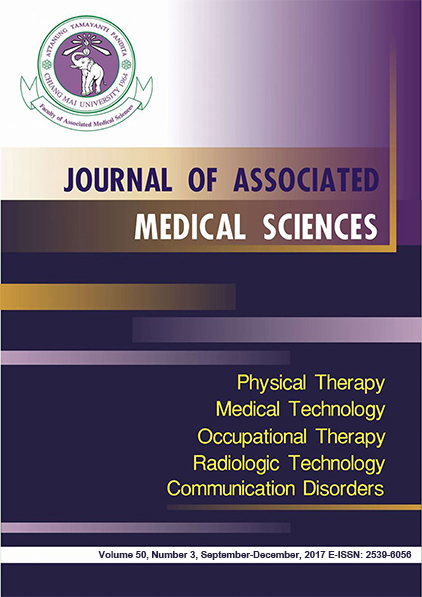Detection of Antinuclear Antibodies in HIV-Infected Individuals
Main Article Content
Abstract
Background: The causes of autoimmune diseases (ADs) are still not clearly known, but it is believed that diseases are propelled by multiple factors including genetic, hormone and environmental factors. For the environmental factors that trigger ADs, infection is one of the important factor. In the present study, we seek to disclose whether HIV infection instigate autoimmune diseases.
Objectives: To investigate the proportion of antinuclear antibodies (ANA)-positive persons in HIV-infected patients.
Materials and methods: Blood samples were obtained from 76 HIV-infected patients and 100 healthy donors. Separated plasma from these samples were subjected to the ANA analysis by indirect immunofluorescent assay.
Results: A positive-ANA test was detected in 25% and 22% from HIV-infected patients and healthy blood donors, respectively. The ANA-positive result in female healthy donors tends to be higher than that of a male group, whereas the ANA-positive result in males seemed to be higher in HIV-infected patients, assuming that sex hormone may play some notable roles in altering an immune response to favor an autoimmunity. Moreover, high ANA-positive proportion was found in the oldest subject group and in HIV-infected patients the highest ANA-positive proportion was found in the group with the longest infection duration, assuming that age and chronic infection may also involve in ANA production.
Conclusion: Though the proportion of HIV-infected patients who had ANA positive results was not statistically significant different when compared to that of healthy blood donors, the tendency of the proportion seems to be higher in HIV-infected group. The highest proportion was found in the patients with the longest infection duration. Therefore, it could be suspected that chronic HIV infection might be associated with ANA production.
Article Details
Personal views expressed by the contributors in their articles are not necessarily those of the Journal of Associated Medical Sciences, Faculty of Associated Medical Sciences, Chiang Mai University.
References
2. Kaliyadan F. HIV and lupus erythematosus: a diagnostic dilemma. Indian J Dermatol. 2008; 53(2): 80-2.
3. Rawson PM, Molette C, Videtta M, Altieri L, Franceschini D, Donato T, et al. Cross-presentation of caspase-cleaved apoptotic self antigens in HIV infection. Nat Med. 2007; 13(12): 1431-9.
4. Rowland-Jones S, Dong T. Dying T cells trigger autoimmunity in HIV. Nat Med. 2007; 13(12): 1413-5.
5. Moir S, Fauci AS. Pathogenic mechanisms of B-lymphocyte dysfuction in HIV disease. J Allergy Clin Immunol. 2008; 122(1):12-9.
6. Gisele Zandman-Goddard YS. HIV and autoimmunity. Autoimmun Rev. 2002.
7. Stahl D, Lacroix-Desmazes S, Misra N, Karmochkine M, Kaveri SV, Costagliola D, et al. Alterations of self-reactive antibody repertoires in HIV disease: an insight into the role of T cells in the selection of autoreactive B cells. Immunol Lett. 2005; 99(2): 198-208.
8. Tsiakalos A, Routsias JG, Kordossis T, Moutsopoulos HM, Tzioufas AG, Sipsas NV. Fine epitope specificity of anti-erythropoietin antibodies reveals molecular mimicry with HIV-1 p17 protein: a pathogenetic mechanism for HIV-1-related anemia. J Infect Dis. 2011; 204(6): 902-11.
9. Martinez V, Diemert MC, Braibant M, Potard V, Charuel JL, Barin F, et al. Anticardiolipin antibodies in HIV infection are independently associated with antibodies to the membrane proximal external region of gp41 and with cell-associated HIV DNA and immune activation. Clin Infect Dis. 2009; 48(1): 123-32.
10. Savige JA, Chang L, Horn S, Crowe SM. Anti-nuclear, anti-neutrophil cytoplasmic and anti-glomerular basement membrane antibodies in HIV-infected individuals. Autoimmunity. 1994; 18(3): 205-11.
11. Kulthanan K, Jiamton S, Omcharoen V, Linpiyawan R, Ruangpeerakul J, Sivayathorn A. Autoimmune and rheumatic manifestations and antinuclear antibody study in HIV-infected Thai patients. Int J Dermatol. 2002; 41(7): 417-22.
12. Krishnan K, Panchapakesa C, Porkodi R, Madhavan R, Santh G, Mahesh A.. rheumatological manifestations in hiv positive patients referred to a teriary care centre. J Indian Rheumatol Assoc. 2003; 11(1): 104 - 8.
13. de Vlam K, De Keyser F, Verbruggen G, Vandenbossche M, Vanneuville B, D’Haese D, et al. Detection and identification of antinuclear autoantibodies in the serum of normal blood donors. Clin Exp Rheumatol. 1993; 11(4): 393-7.
14. Fernandez SA, Lobo AZ, Oliveira ZN, Fukumori LM, AM Pr, Rivitti EA. Prevalence of antinuclear autoantibodies in the serum of normal blood dornors. Revista do Hospital das Clinicas. 2003; 58(6): 315-9.
15. Guo YP, Wang CG, Liu X, Huang YQ, Guo DL, Jing XZ, et al. The prevalence of antinuclear antibodies in the general population of china: a cross-sectional study. Curr Ther Res Clin Exp. 2014; 76: 116-9.
16. Sankar J, Raj D, Sankar J, Sharma PK, Lodha R, Kabra SK. HIV infection mimicking autoimmune disorder. Indian J Pediatr. 2007; 74(8): 777-80.
17. Baig MM, Shere SJ. Prevalence of autoantibodies in Saudi population. J Med. 1989; 20(3-4): 286-90.
18. Manoussakis MN, Tzioufas AG, Silis MP, Pange PJ, Goudevenos J, Moutsopoulos HM. High prevalence of anti-cardiolipin and other autoantibodies in a healthy elderly population. Clin Exp Immunol. 1987; 69(3): 557-65.
19. Goemaere S, Ackerman C, Goethals K, De Keyser F, Van der Straeten C, Verbruggen G, et al. Onset of symptoms of rheumatoid arthritis in relation to age, sex and menopausal transition. J Rheumatol. 1990; 17(12): 1620-2.
20. Azizah MR, Shahnaz M, Zulkifli MN, Nasuruddin BA. Anti-nuclear, anti-mitochondrial, anti-smooth muscle and anti-parietal cell antibodies in the healthy Malaysian population. Malays J Pathol. 1995; 17(2): 83-6.
21. Lahita RG. Sex steroids and the rheumatic diseases. Arthritis Rheum. 1985; 28(2): 121-6.
22. Makinodan T, Kay MM. Age influence on the immune system. Adv Immunol. 1980; 29: 287-330.


